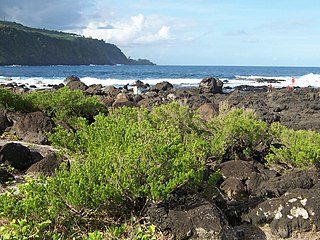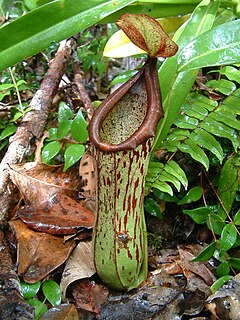
Manilkara is a genus of trees in the family Sapotaceae. They are widespread in tropical and semitropical locations, in Africa, Madagascar, Asia, Australia, and Latin America, as well as various islands in the Pacific and in the Caribbean. A close relative is the genus Pouteria.

Vachellia farnesiana, also known as Acacia farnesiana, and previously Mimosa farnesiana, commonly known as sweet acacia, huisache, or needle bush, is a species of shrub or small tree in the legume family, Fabaceae. It is deciduous over part of its range, but evergreen in most locales. The species grows to a height of 15–30 feet (4.6–9.1 m) and grows multiple trunks. The base of each leaf is accompanied by a pair of thorns on the branch. Its flowers are used in the perfume industry.

Cordyline is a genus of about 15 species of woody monocotyledonous flowering plants in family Asparagaceae, subfamily Lomandroideae. The subfamily has previously been treated as a separate family Laxmanniaceae, or Lomandraceae. Other authors have placed the genus in the Agavaceae. Cordyline is native to the western Pacific Ocean region, from New Zealand, eastern Australia, southeastern Asia and Polynesia, with one species found in southeastern South America.

The amethystine python, also known as the scrub python or sanca permata locally, is a species of non-venomous snake in the family Pythonidae. The species is found in Indonesia, Papua New Guinea, and Australia. Popular among reptile enthusiasts, and noted for its coloration and size, it is one of the six largest snakes in the world, as measured either by length or weight, and is the largest native snake in Australia and Papua New Guinea.
Alfred Voeltzkow was a German zoologist and botanist from Berlin, Brandenburg.

Cyrtostachys is a genus of flowering plant in the family Arecaceae. Its species are found in southeast Asia, New Guinea, and in some of the South-Central and Southwest Pacific island habitats of the Oceanian realm.

Deckenia nobilis is a species of flowering plant in the family Arecaceae. It is monotypic within the genus Deckenia, and is endemic to the Seychelles, where it is threatened by habitat loss. It was described in 1870.
Dypsis ambanjae is a species of flowering plant in the family Arecaceae, endemic to the Madagascarian rainforests. The last specimen was collected more than 80 years ago, and it may be extinct. Although originally treated under the genus Phloga in 1933, it was published under the currently accepted nomenclature in 1995.
Alloxylon brachycarpum is a species of plant in the family Proteaceae. It is found in Indonesia and Papua New Guinea. It is threatened by habitat loss.
Horsfieldia ampla is a small rare tree with small (4×2 mm) yellow flowers in the family Myristicaceae, known only from its type collection. It is endemic to Papua New Guinea, where it is only found in those provinces associated with the Sepik river, growing in dense humid forest.
Manilkara gonavensis is a tree species in the sapodilla family, found nowhere else but Haiti. It has only ever been collected one time for study, when the type specimen was taken. This was in the early 20th century, before 1929, which is the year it was described. Consequently, very little is known about M. gonavensis, and further study is needed. The specimen was taken from Haiti's Gonâve Island, which is reflected in the choice of its specific epithet.

Pemphis is a genus of maritime plants in family Lythraceae. It was recently thought have only one species but is now believed to have at least two.

Parentucellia is a small genus of flowering plants in the family Orobanchaceae containing about four species. They are known generally as glandweeds. The genus was named for Pope Nicholas V, whose surname was Parentucelli.

Rhus taitensis is a small tree or shrub in the sumac family of plants. It is found from tropical Asia, to Australia and many islands of the Pacific ocean. The chemical tetrahydroxysqualene from dried and ground parts of R. taitensis has in vitro activity against Mycobacterium tuberculosis and the plant has been used in folk medicine locally to treat diarrhea and hearing loss.
The Kaijende Highlands are a nearly uninhabited expanse of mountains near Porgera in Enga Province, Papua New Guinea. The highlands have been characterized as "some of Papua New Guinea's most pristine and scenic montane habitat". The Kaijende Highlands include Lake Tawa, Paiela Road, Omyaka Creek, Waile Creek and the Porgera Reservoir. The mountain range is 70 km north-west of Mount Hagen. According to a survey conducted in 2007, "areas like Kaijende are characterized by pronounced dominance of microtherm families, most notably by Cunoniaceae, Epacridaceae, Ericaceae, Geraniaceae, Myrsinaceae, Podocarpaceae, Ranunculaceae, Rosaceae, Theaceae, Violaceae, and Winteraceae."
Finschia is a genus of three recognised species of large trees, constituting part of the plant family Proteaceae. They grow naturally in New Guinea and its surrounding region, in habitats from luxuriant lowland rainforests to steep highland forests.

Saribus woodfordii is a species of fan palm which is native to an area from southeastern Papua New Guinea to the Solomon Islands.

Nepenthes biak is a tropical pitcher plant endemic to the Indonesian island of Biak, after which it is named. Biak is a member of the Schouten Islands, located in Cenderawasih Bay, and is administered as part of Biak Numfor Regency, Papua Province. Nepenthes biak grows near sea level, usually on limestone coastal cliffs though occasionally as an epiphyte on mangrove trees.
Saribus chocolatinus is a species of palm tree in the genus Saribus, which is native to Papua New Guinea. It is a fan palm.
Alan W. Archer is a mycologist. He is currently an honorary research associate at Royal Botanic Gardens Sydney, and working on the chemotaxonomy of the lichen genus Pertusaria together with a key to all taxa in that genus.










